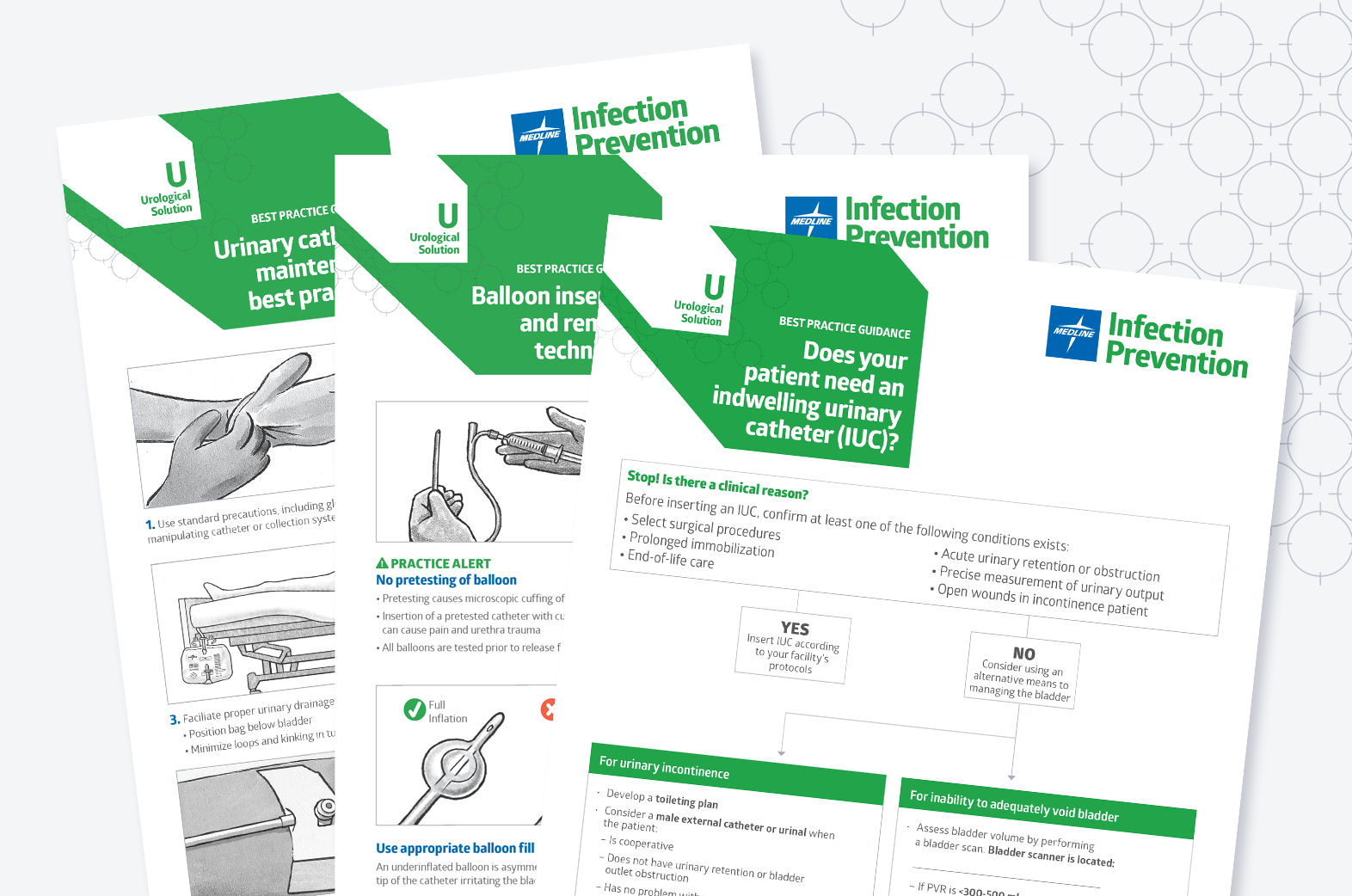Catheter balloons and catheter drainage bags: How-to posters
Access guidance and techniques from downloadable Foley catheter pieces.

Catheter associated urinary tract infections (CAUTIs) are among the most common healthcare-associated infections (HAIs).1 In the US, it’s estimated that more than 2.5 million unnecessary catheters are placed every year.2 In fact, indwelling urinary catheters (IUCs) are unnecessary in 1 in 3 patients – and each day of catheter dwell time adds a 3-7% risk of infection.3,4
15–20%
of all hospitalized patients receive urinary catheters1
75%
of healthcare-associated UTIs are caused by an indwelling urinary catheter (IUC)1
More than 2.5 million
unnecessary catheters are placed every year2
The good news is that most CAUTIs can be prevented by following evidence-based guidelines—and training can make a big difference. That’s because even though the need to prevent CAUTIs is well understood, new practices and alternatives to indwelling urinary catheters may not be as clear. These educational posters are specially designed to help.
“The IUC or Foley catheter is a basic tool for nurses,” says Mary Pat Eble, MSN, RN, Medline Clinical Product Specialist-Urology. “We learn it once in school and never revisit it. But best practices have evolved, forcing us to question whether and when it’s OK to use an IUC. That’s why so much education is needed. Unless nurses learn the most current evidence-based approaches, they’ll continue with whatever they learned in nursing school, right or wrong.”

Posters help clinicians and facilities “target zero”
The Centers for Disease Control and Prevention (CDC) consider CAUTI a “never event,” meaning a CAUTI should never occur because it’s reasonably preventable when best practices are followed.
Says Eble, “The goal is zero harm, but it’s very difficult to get there. With so many variables including the differing acuities of patients, I like to use the term “targeting zero.” You get there by going back to basics, focusing on best practices and doing all you can do to support them.”
Eble previously helped nurses across the country revalidate their catheter insertion skills. She says, “It takes a while for clinicians to hard wire a new practice, to do it so many times it becomes second nature. Posters are extremely helpful in reinforcing best practices.”
Give CAUTI time and attention for best results
Eble recommends choosing one CAUTI prevention best practice poster per month and highlighting it in different ways. Here are a few of her tips:
- Decide what your monthly CAUTI “talk track” will be and use a poster to support it. It might be, “Do you really need an IUC?” or “Remember to get the Foley out – it shouldn’t be there if it’s not needed.”
- Dedicate time in morning and evening safety huddles to highlight the details and steps on the poster. Five minutes two to three times per week is enough. These “shout outs” keep the material fresh with just enough repetition to be an effective reminder.
- Display the featured poster in high traffic areas as a reinforcement – on a bulletin board, in the nurses’ restroom or in nursing stations. Rotate a new one in each month.
- Stage an in-service product demo highlighting use of an IUC alternative like a bladder scanner, external catheter or an intermittent catheter tray.
This “decision tree” poster helps clinicians determine if a catheter is needed and when alternatives like an external catheter or bladder scanner are appropriate.
Poster 2: Balloon insertion and removal techniques
This catheter best practice poster illustrates the steps clinicians should take to safely manage the IUC’s balloon.
This catheter maintenance bundle poster helps clinicians take consistent steps to reduce CAUTI.
Key takeaway
Catheter associated urinary tract infections (CAUTIs) are one of the most common HAIs, largely attributable to the overuse of indwelling urinary catheters (IUCs). The good news is that CAUTI is highly preventable when best practices are followed and IUC alternatives are used. Posters are an essential training tool and help keep CAUTI awareness and best practices high.
Looking for more ways to help your clinicians reduce CAUTIs?
Request a Discovery Assessment to identify gaps in care at your facility and receive a customized action plan to help reduce CAUTI rates.
Create a culture of CAUTI prevention with a comprehensive Urological Solution featuring best practice guidance, education and a system of products.
Download more posters and discover CAUTI prevention educational resources at Medline University.
Learn more about a system of products designed to help reduce indwelling catheter use.
References:
- Content source: Centers for Disease Control and Prevention, National Center for Emerging and Zoonotic Infectious Diseases (NCEZID), Division of Healthcare Quality Promotion (DHQP) Page last reviewed: October 16, 2015. Available at: https://www.cdc.gov/hai/ca_uti/uti.html.
- How-To Guide: Prevent Catheter-Associated Urinary Tract Infection. Institute for Healthcare Improvement; 2011. Available at: http://www.ihi.org/resources/Pages/Tools/HowtoGuidePreventCatheterAssociatedUrinaryTractInfection.aspx. Accessed August 21, 2015.
- McGuckin M. The patient survival guide: 8 simple solutions to prevent hospital and healthcare-associated infections. New York, NY: Demos Medical Publishing; 2012.
- Lo E, Nicolle LE, Coffin SE, Gould C, Maragakis LL, Meddings J, et al. Strategies to prevent catheter associated urinary tract infections in acute care hospitals: 2014 update. Infection Control and Hospital Epidemiology 2014; 35:464-79.
